Influence of Pasture Stocking Method on Surface Runoff and Nutrient Loss in the US Upper Midwest
Abstract
:1. Introduction
2. Materials and Methods
2.1. Site Description
2.2. Hay Field Treatments and Manure Applications
2.3. Grazing System Treatments
2.4. Surface Runoff and Related Nutrient Measures
2.5. Statistical Methods
3. Results and Discussion
3.1. Weather Conditions
3.2. Manure Nitrogen and Phosphorus Inputs
3.3. Surface Runoff Hydrology and Suspended Sediment Loss
3.4. Nitrogen Concentrations and Loads
3.5. Phosphorus Concentrations and Loads
3.6. Importance of Snowmelt and Non-Growing Season Runoff
4. Conclusions
Supplementary Materials
Author Contributions
Funding
Data Availability Statement
Acknowledgments
Conflicts of Interest
References
- Gerrish, J. Management-Intensive Grazing: The Grassroots of Grass Farming; Green Park Press: Purvis, MI, USA, 2004. [Google Scholar]
- Oates, L.G.; Jackson, R.D. Livestock management strategy affects net ecosystem carbon balance of subhumid pasture. Rangel. Ecol. Manag. 2014, 67, 19–29. [Google Scholar] [CrossRef]
- Oates, L.G.; Undersander, D.J.; Gratton, C.; Bell, M.M.; Jackson, R.D. Management-intensive rotational grazing enhances forage production and quality of subhumid cool-season pastures. Crop Sci. 2011, 51, 892. [Google Scholar] [CrossRef]
- Rudstrom, M.H.; Chester-Jones, P.; Imdieke, R.; Johnson, D.; Reese, M.; Singh, A. Comparison of economic and animal performance of dairy heifers in feedlot and pasture-based systems. Prof. Anim. Sci. 2005, 21, 38–44. [Google Scholar] [CrossRef]
- Franzluebbers, A.J.; Paine, L.K.; Winsten, J.R.; Krome, M.; Sanderson, M.A.; Ogles, K.; Thompson, D. Well-managed grazing systems: A forgotten hero of conservation. J. Soil Water Conserv. 2012, 67, 100A–104A. [Google Scholar] [CrossRef]
- Rui, Y.; Jackson, R.D.; Cotrufo, M.F.; Ruark, M.D. Persistent soil carbon enhanced in mollisols by well-managed grassland but not annual grain or dairy forage cropping systems. Proc. Natl. Acad. Sci. USA 2022, 119, e2118931119. [Google Scholar] [CrossRef] [PubMed]
- Zhang, X.; Lark, T.J.; Clark, C.M.; Yuan, Y.; LeDuc, S.D. Grassland-to-cropland conversion increased soil, nutrient, and carbon losses in the US Midwest between 2008 and 2016. Environ. Res. Lett. 2021, 16, 054018. [Google Scholar] [CrossRef] [PubMed]
- Campbell, T.A.; Booth, E.G.; Gratton, C.; Jackson, R.D.; Kucharik, C.J. Agricultural landscape transformation needed to meet water quality goals in the Yahara River Watershed of Southern Wisconsin. Ecosystems 2022, 25, 507–525. [Google Scholar] [CrossRef]
- Grandin, T. Grazing cattle, sheep, and goats are important parts of a sustainable agricultural future. Animals. 2022, 12, 2092. [Google Scholar] [CrossRef]
- Jackson, R.D. Soil nitrate leaching under grazed cool-season grass pastures of the North Central US. J. Sci. Food Agric. 2020, 200, 5307–5312. [Google Scholar] [CrossRef]
- Allen, V.G.; Batello, C.; Berretta, E.; Hodgson, J.; Kothmann, M.; Li, X.; McIvor, J.; Milne, J.; Morris, C.; Peeters, A.; et al. An international terminology for grazing lands and grazing animals. Grass Forage Sci. 2011, 66, 2–28. [Google Scholar] [CrossRef]
- Faust, D.R.; Kumar, S.; Archer, D.W.; Hendrickson, J.R.; Krongberg, S.L.; Liebig, M.A. Integrated crop-livestock systems and water quality in the Northern Great Plains: Review of current practices and future research needs. J. Environ. Qual. 2018, 47, 1–15. [Google Scholar] [CrossRef] [PubMed]
- Schepers, J.S.; Francis, D.D. Chemical water quality of runoff from grazing land in Nebraska: 1. Influence of grazing livestock. J. Environ. Qual. 1982, 11, 351–354. [Google Scholar] [CrossRef]
- Sanjari, G.; Yu, B.; Ghadiri, H.; Ciesiolka, C.A.; Ciesiolka, C.W. Effects of time-controlled grazing on runoff and sediment loss. Aust. J. Soil Res. 2009, 47, 796–808. [Google Scholar] [CrossRef]
- Lambert, M.G. Losses of nitrogen, phosphorus and sediment in runoff from hill country under different ertilizer and grazing management regimes. N. Z. J. Agric. Res. 1985, 28, 371–379. [Google Scholar] [CrossRef]
- Park, J.Y.; Ale, S.; Teague, W.R. Simulated water quality effects of alternate grazing management practices at the ranch and watershed scales. Ecol. Model. 2017, 360, 1–13. [Google Scholar] [CrossRef]
- Bilotta, G.S.; Brazier, R.E.; Haygarth, P.M. The impacts of grazing animals on the quality of soils, vegetation, and surface waters in intensively managed grasslands. Adv. Agron. 2007, 94, 237–280. [Google Scholar]
- Centeri, C. Effects of grazing on water erosion, compaction and infiltration on grasslands. Hydrology 2022, 9, 34. [Google Scholar] [CrossRef]
- Daniel, J.A.; Phillips, W.A.; Northup, B.K. Influence of summer management practices of grazed wheat pastures on runoff, sediment, and nutrient losses. Trans. ASABE. 2006, 49, 349–355. [Google Scholar] [CrossRef]
- Emmerich, W.; Heitschmidt, R. Drought and grazing: II. Effects on runoff and water quality. J. Range Manag. 2002, 55, 229–234. [Google Scholar] [CrossRef]
- Elliott, A.H.; Tian, Y.Q.; Rutherford, J.C.; Carlson, W.T. Effect of cattle treading on interrill erosion from hill pasture: Modelling concepts and analysis of rainfall simulator data. Aust. J. Soil Res. 2002, 40, 963–976. [Google Scholar] [CrossRef]
- Blanco-Canqui, H.; Stalker, A.L.; Rasby, R.; Shaver, T.M.; Drewnoski, M.E.; van Donk, S.; Kibet, L. Does cattle grazing and baling of corn residue increase water erosion? Soil Sci. Soc. Am. J. 2016, 80, 168–177. [Google Scholar] [CrossRef]
- Vadas, P.A.; Busch, D.L.; Powell, J.M.; Brink, G.E. Monitoring runoff from cattle-grazed pastures for a phosphorus loss quantification tool. Agric. Ecosyst. Environ. 2019, 199, 124–131. [Google Scholar] [CrossRef]
- Capece, J.C.; Campbell, K.L.; Bohlen, P.J.; Graetz, D.A.; Portier, K.M. Soil phosphorus, cattle stocking rates, and water quality in subtropical pastures in Florida, USA. Rangel. Ecol. Manag. 2007, 60, 19–30. [Google Scholar] [CrossRef]
- Dougherty, W.J.; Nicholls, P.J.; Milham, P.J.; Havilah, E.J.; and Lawrie, R.A. Phosphorus fertilizer and grazing management effects on phosphorus in runoff from dairy pastures. J. Environ. Qual. 2008, 37, 417–428. [Google Scholar] [CrossRef] [PubMed]
- Nash, D.M.; McDowell, R.W.; Condron, L.M.; McLaughlin, M.J. Direct Exports of Phosphorus from Fertilizers Applied to Grazed Pastures. J. Environ. Qual. 2019, 48, 1380–1396. [Google Scholar] [CrossRef] [PubMed]
- Owens, L.B.; Shipitalo, M.J. Surface and subsurface phosphorus losses from fertilized pasture systems in Ohio. J. Environ. Qual. 2006, 35, 1101–1109. [Google Scholar] [CrossRef] [PubMed]
- O’Reagain, P.J.; Brodie, J.; Fraser, G.; Bushell, J.J.; Holloway, C.H.; Faithful, J.W.; Haynes, D. Nutrient loss and water quality under extensive grazing in the upper Burdekin river catchment, North Queensland. Mar. Pollut. Bull. 2005, 51, 37–50. [Google Scholar] [CrossRef]
- Vadas, P.A.; Aarons, S.R.; Butler, D.M.; and Dougherty, W.J. A new model for dung decomposition and phosphorus transformations and loss in runoff. Soil Res. 2011, 49, 367–375. [Google Scholar] [CrossRef]
- Lyons, J.; Weasel, B.M.; Paine, L.K.; Undersander, D.J. Influence of intensive rotational grazing on bank erosion, fish habitat quality, and fish communities in Southwestern Wisconsin trout streams. J. Soil Water Conserv. 2000, 55, 271–276. [Google Scholar]
- Jokela, W.E.; Casler, M.D. Transport of phosphorus and nitrogen in surface runoff in a corn silage system: Paired watershed methodology and calibration period results. Can. J. Soil Sci. 2011, 91, 479–491. [Google Scholar] [CrossRef]
- Sherman, J.F.; Young, E.O.; Jokela, W.E.; Casler, M.D.; Coblentz, W.K.; Cavadini, J. Influence of soil and manure management practices on surface runoff phosphorus and nitrogen loss in a corn silage production system: A paired watershed approach. Soil Syst. 2021, 5, 1. [Google Scholar] [CrossRef]
- Peters, J. Recommended Methods of Manure Analysis; University of Wisconsin-Extension: Madison, WI, USA, 2003. [Google Scholar]
- Teague, R.; Barnes, M. Grazing management that regenerates ecosystem function and grazing land livelihoods. Afr. J. Range Forage Sci. 2017, 34, 77–86. [Google Scholar] [CrossRef]
- Laboski, C.A.; Peters, J.B.; Bundy, L.G. Nutrient Application Guidelines for Field, Vegetable, and Fruit Crops in Wisconsin; Division of Cooperative Extension of the University of Wisconsin-Extension: Madison, WI, USA, 2006. [Google Scholar]
- Stuntebeck, T.D.; Komiskey, M.J.; Owens, D.W.; Hall, D.W. Methods of Data Collection, Sample Processing, and Data Analysis for Edge-of-Field, Streamgaging, Subsurface-Tile, and Meteorological Stations at Discovery Farms and Pioneer Farm in Wisconsin, 2001–2007; US Geological Survey: Reston, VA, USA, 2008.
- APHA. Standard Methods for the Examination of Water and Wastewater, 19th ed.; American Public Health Association; American Water Works Association; Water Environment Federation: Washington, DC, USA, 1995. [Google Scholar]
- ASTM International (Ed.) Standard Test Method for Determining Sediment Concentration in Water Samples; ASTM International: West Conshohocken, PA, USA, 2000. [Google Scholar]
- Patton, C.J.; Kryskalla, J.R. Methods of Analysis by the US Geological Survey National Water Quality Laboratory: Evaluation of Alkaline Persulfate Digestion as an Alternative to Kjeldahl Digestion for the Determination of Total and Dissolved Nitrogen and Phosphorus in Water; Water Resources Investigations, Rep. 03-4174; USGS, Branch of Information Services, Federal Center: Denver, CO, USA, 2003.
- Laboski, C.A.M.; Peters, J.B. Nutrient Application Guidelines for Field, Vegetable, and Fruit Crops in Wisconsin; University of Wisconsin-Extension, Cooperative Extension: Madison, WI, USA, 2012. [Google Scholar]
- Schulte, E.E.; Hopkins, B.G. Estimation of soil organic matter by weight 3. Organic matter (LOI) loss-on-ignition. In Soil Organic Matter: Analysis and Interpretation; Magdoff, F.R., Tabatabai, M.A., Hanlon, E.A., Jr., Eds.; Soil Science Society of America: Madison, WI, USA, 1996; pp. 21–31. [Google Scholar]
- Thomas, G.W. Soil pH and soil acidity. In Methods of Soil Analysis Part 3: Chemical Methods; Sparks, D.L., Ed.; Soil Science Society of America: Madison, WI, USA, 1996; pp. 475–490. [Google Scholar]
- Bray, R.H.; Kurtz, L.T. Determination of total, organic, and available forms of phosphorus in soil. Soil Sci. 1945, 59, 39–45. [Google Scholar] [CrossRef]
- Clausen, J.C.; Spooner, J. Paired Watershed Study Design; USEPA Publ. 841-F-93–009; U.S. Environ. Protection Agency: Washington, DC, USA, 1993.
- SAS Institute Inc. SAS 9.4 Guide to Software Updates; SAS Institute Inc.: Cary, NC, USA, 2013. [Google Scholar]
- Good, L.W.; Carvin, R.; Lamba, J.; Fitzpatrick, F.A. Seasonal variation in sediment and phosphorus yields in four Wisconsin agricultural watersheds. J. Environ. Qual. 2019, 48, 950–958. [Google Scholar] [CrossRef] [PubMed]
- Good, L.W.; Vadas, P.; Panuska, J.C.; Bonilla, C.A.; Jokela, W.E. Testing the Wisconsin Phosphorus Index with Year-Round, Field-Scale Runoff Monitoring. J. Environ. Qual. 2012, 41, 1730–1740. [Google Scholar] [CrossRef] [PubMed]
- Vandegrift, T.R.; Stefan, H.G. Annual Stream Runoff and Climate in Minnesota’s River Basins; Project Report; University Minnesota St. Anthony Falls Lab: Minneapolis, MN, USA, 2010; Volume 543, pp. 1–31. [Google Scholar]
- Stock, M.N.; Arriaga, F.J.; Vadas, P.A.; Good, L.W.; Casler, M.D.; Karthikeyan, K.G.; Zopp, Z. Fall tillage reduced nutrient loads from liquid manure application during the freezing season. J. Environ. Qual. 2019, 48, 889–898. [Google Scholar] [CrossRef] [PubMed]
- Prasad, L.R.; Thompson, A.M.; Arriaga, F.J.; Vadas, P.A. Tillage and manure effects on runoff nitrogen and phosphorus losses from frozen soils. J. Environ. Qual. 2022, 51, 978–989. [Google Scholar] [CrossRef]
- Gary, H.L.; Jhonson, S.R.; Ponce, S.L. Cattle grazing impact on surface water quality in a Colorado Front Range stream. J. Soil Water Conserv. 1983, 38, 124–128. [Google Scholar]
- Griffith, K.E.; Young, E.O.; Klaiber, L.K.; Kramer, S.R. Winter rye cover crop impacts on runoff water quality in a northern New York (USA) tile-drained maize agroecosystem. Water Air Soil Pollut. 2020, 231, 84. [Google Scholar] [CrossRef]
- Wood, J.C.; Wood, M.K. Infiltration and water quality on range sites at Fort Stanton, New Mexico. Water Resour. Bull. 1988, 24, 317–323. [Google Scholar] [CrossRef]
- Laboski, C.A.M.; Lamb, J.A. Changes in soil test phosphorus concentration after application of manure or fertilizer. Soil Sci. Soc. Am. J. 2003, 67, 544–554. [Google Scholar] [CrossRef]
- Young, E.O.; Ross, D.S.; Jaisi, D.P.; Vidon, P.G. Phosphorus transport along the cropland–riparian–stream continuum in cold climate agroecosystems: A review. Soil Syst. 2012, 5, 15. [Google Scholar] [CrossRef]
- Danz, M.E.; Corsi, S.R.; Brooks, W.R.; Bannerman, R.T. Characterizing response of total suspended solids and total phosphorus loading to weather and watershed characteristics for rainfall and snowmelt events in agricultural watersheds. J. Hydrol. 2013, 507, 249–261. [Google Scholar] [CrossRef]
- Vadas, P.A.; Stock, M.N.; Arriaga, F.J.; Good, L.W.; Karthikeyan, K.G.; Zopp, Z.P. Dynamics of measured and simulated dissolved phosphorus in runoff from winter-applied dairy manure. J. Environ. Qual. 2019, 48, 899–906. [Google Scholar] [CrossRef] [PubMed]
- Hoffman, A.R.; Polebitski, A.S.; Penn, M.R.; Busch, D.L. Long-term variation in agricultural edge-of-field phosphorus transport during snowmelt, rain, and mixed runoff events. J. Environ. Qual. 2019, 48, 931–940. [Google Scholar] [CrossRef] [PubMed]
- Vadas, P.A.; Good, L.W.; Jokela, W.E.; Karthikeyan, K.G.; Arriaga, F.J.; Stock, M. Quantifying the impact of seasonal and short-term manure application decisions on phosphorus loss in surface runoff. J. Environ. Qual. 2017, 46, 1395–1402. [Google Scholar] [CrossRef] [PubMed]
- Costa, D.; Baulch, H.; Elliott, J.; Pomeroy, J.; Wheater, H. Modelling nutrient dynamics in cold agricultural catchments: A Review. Environ. Modell. Softw. 2020, 124, 104586. [Google Scholar] [CrossRef]
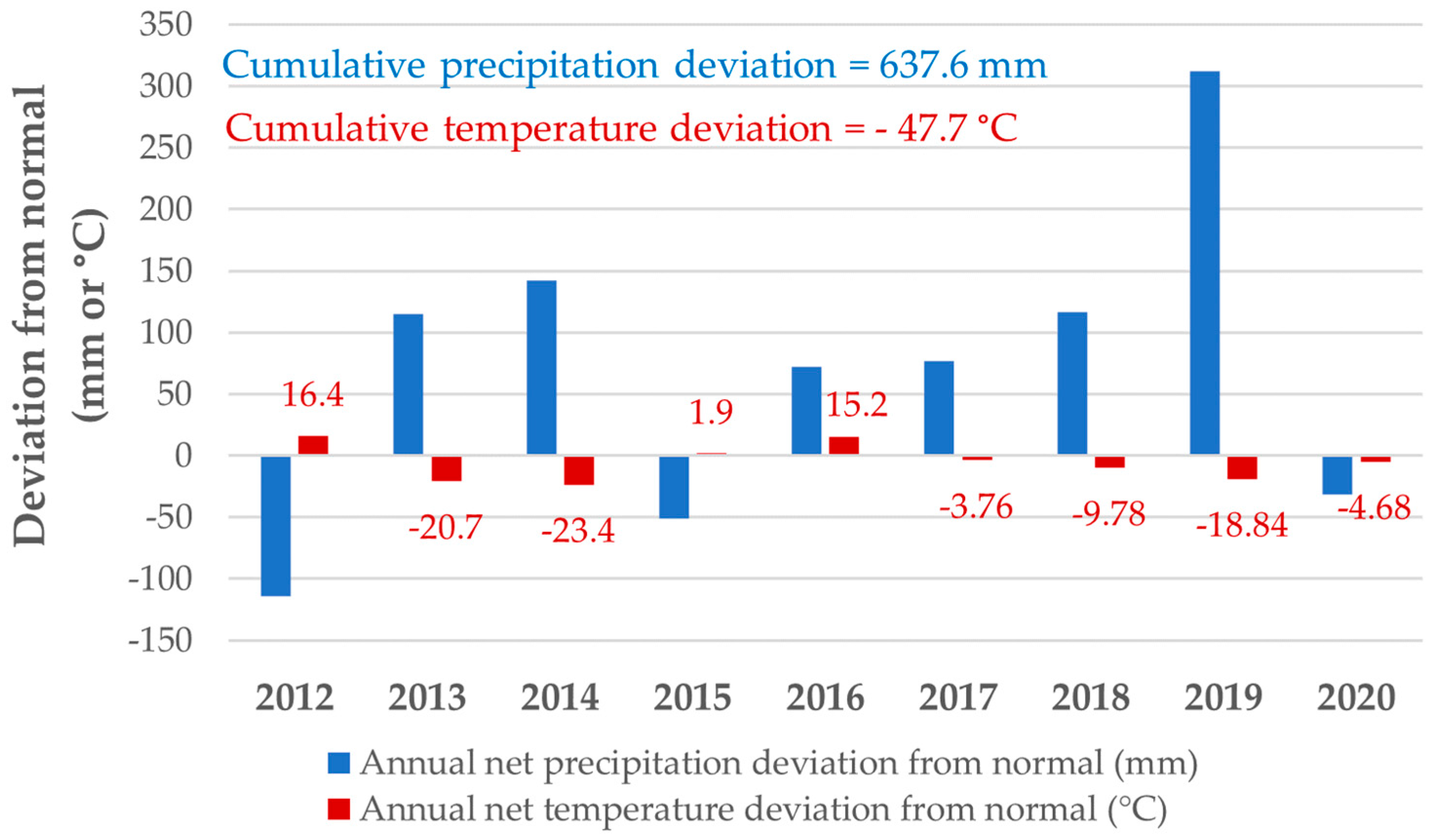

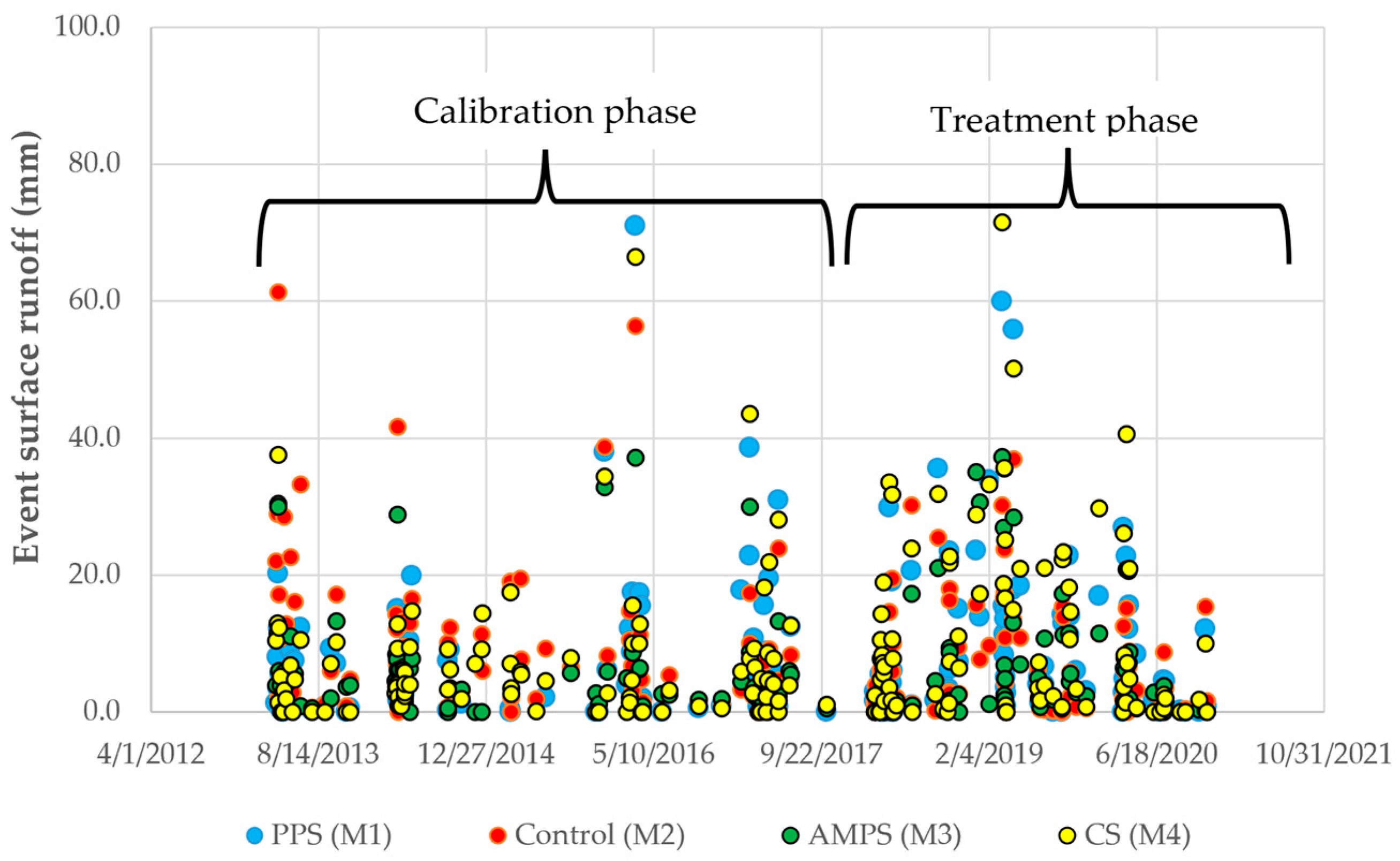
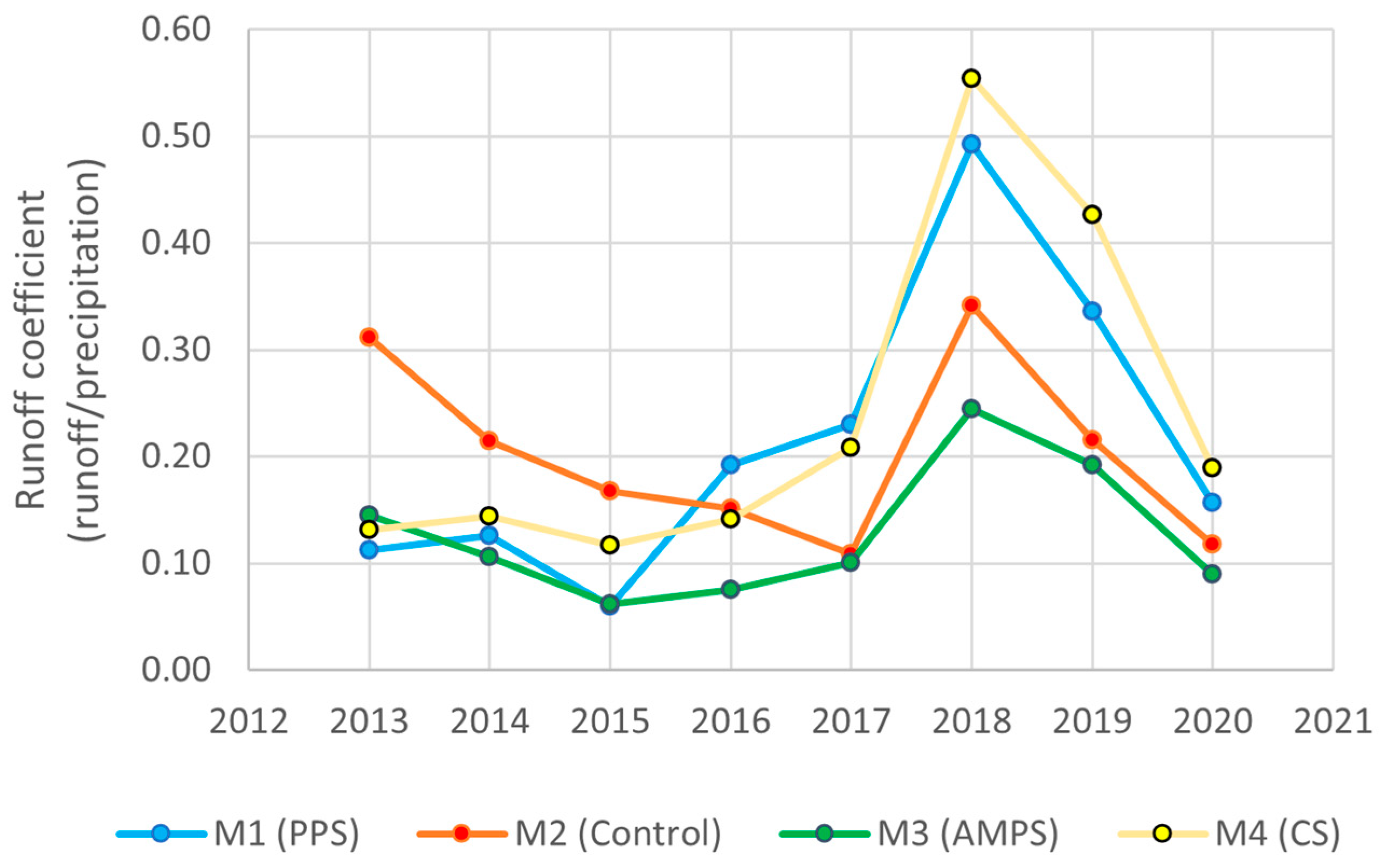

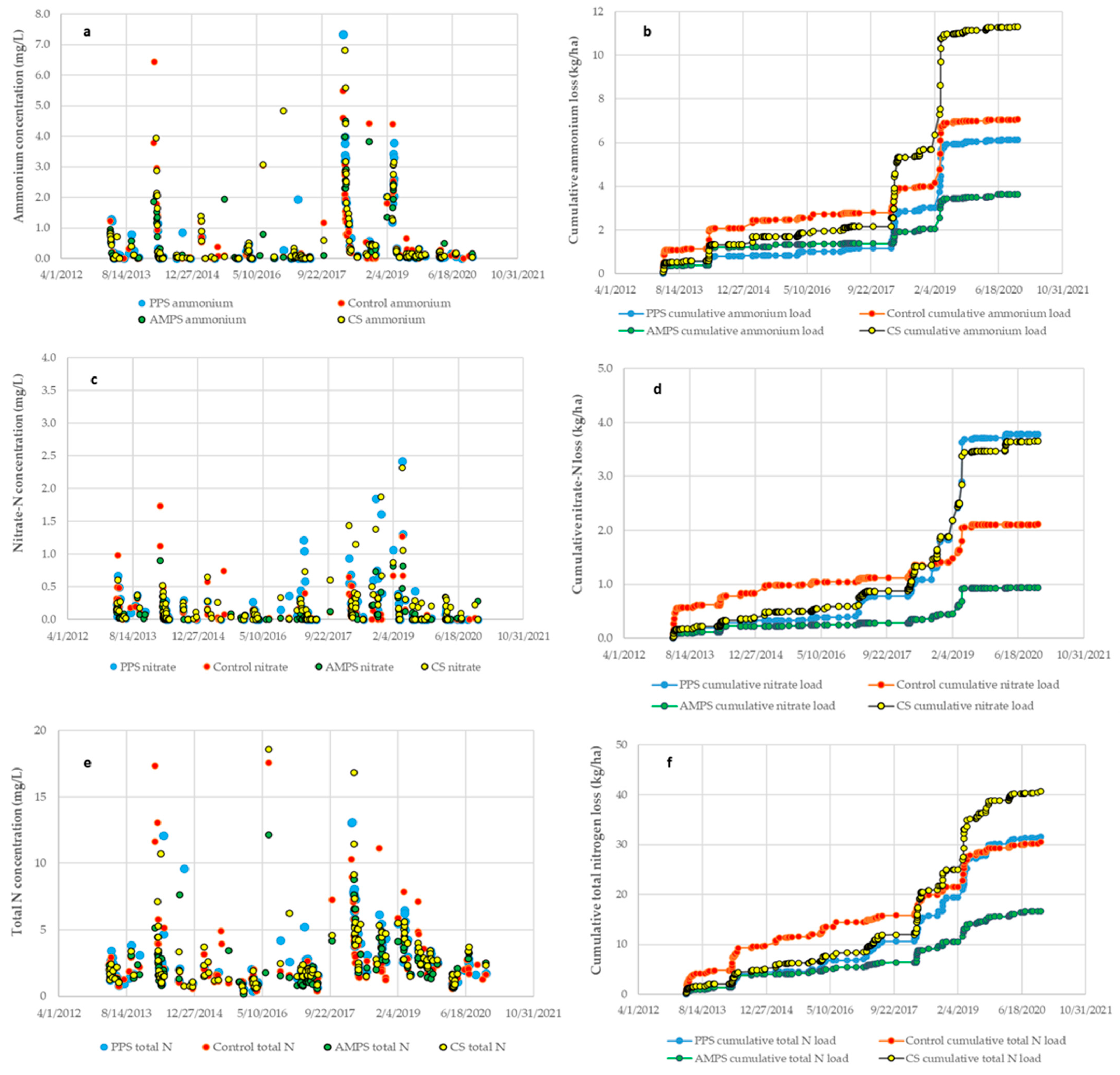

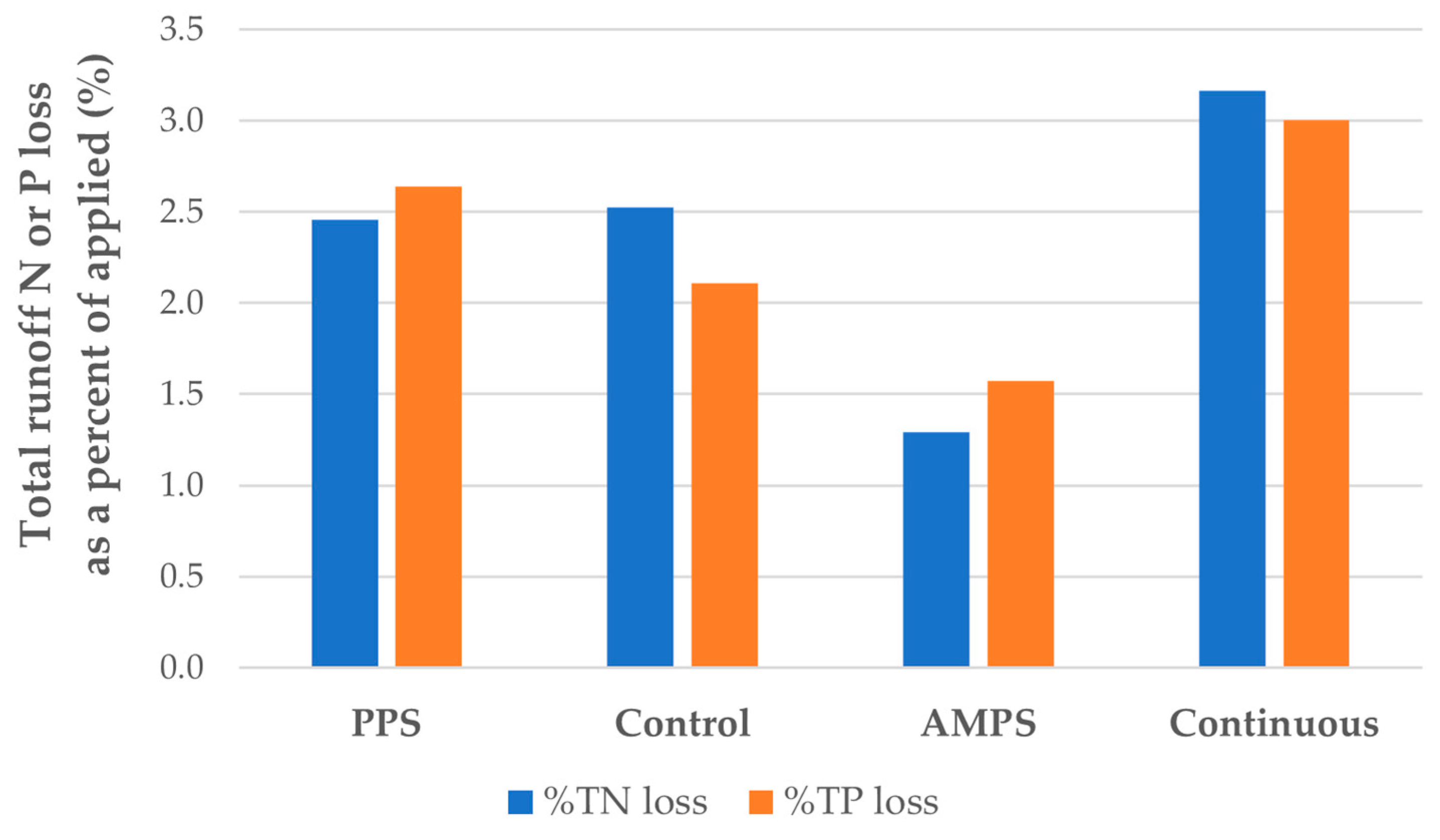
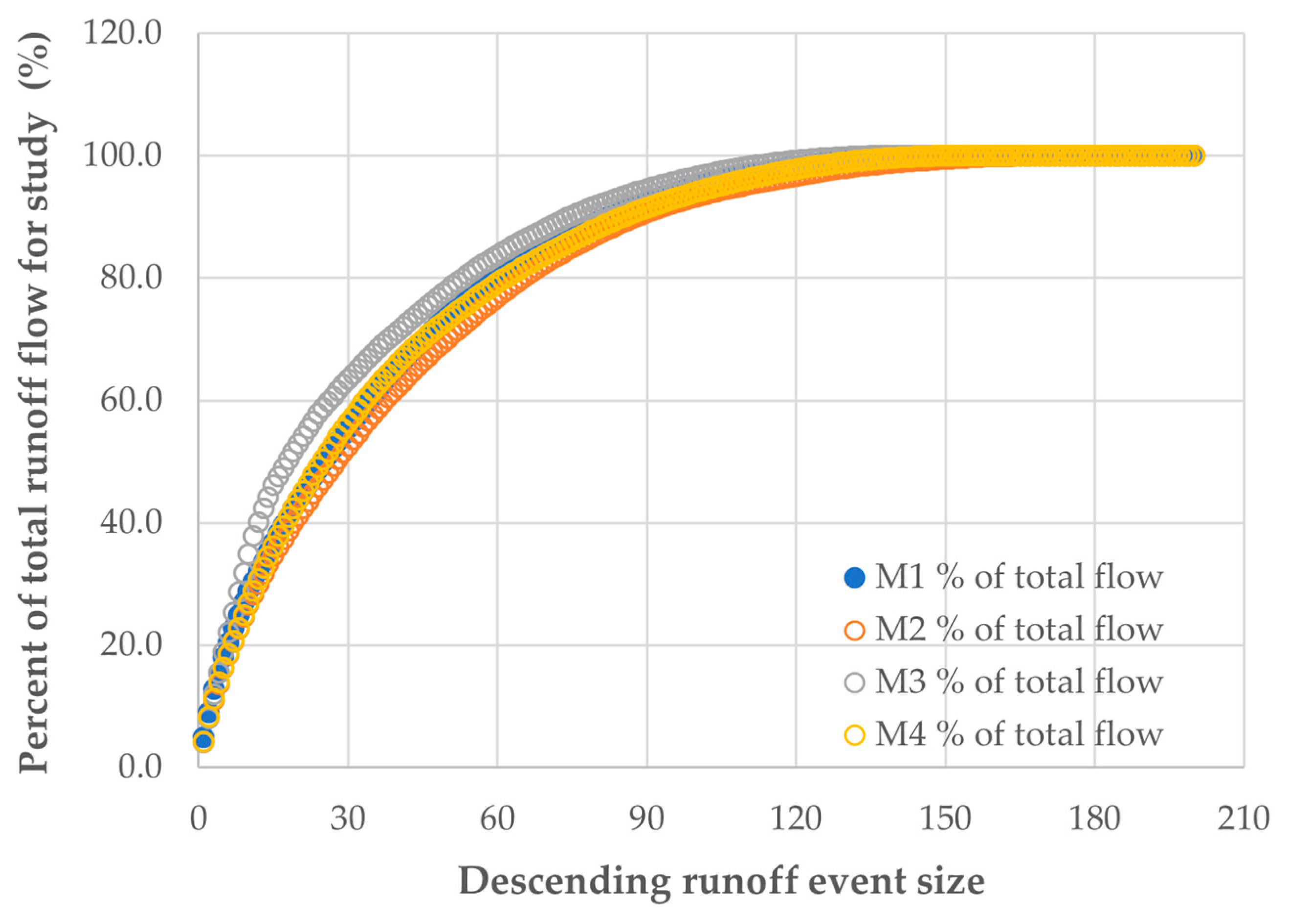
| Treatment | Calibration Mean | Treatment Mean | p1 | p2 | p3 | p4 | |
|---|---|---|---|---|---|---|---|
| Runoff (mm) | PPS6 | 6.7 | 10.6 | NS5 | 0.1 | NS | 0.006 |
| Control7 | - | 7.4 | - | - | - | - | |
| AMPS8 | 4.9 | 7.0 | NS | NS | NS | NS | |
| CS9 | 6.6 | 12.5 | NS | 0.02 | NS | <0.001 | |
| Sediment (mg L−1) | PPS | 16.9 | 10.2 | <0.0001 | NS | NS | NS |
| Control | - | 9.2 | - | - | - | - | |
| AMPS | 13.3 | 9.1 | <0.001 | NS | NS | NS | |
| CS | 15.5 | 12.6 | NS | 0.04 | NS | NS | |
| Sediment load (kg ha−1) | PPS | 1.2 | 1.2 | NS | NS | NS | NS |
| Control | - | 0.80 | - | - | - | - | |
| AMPS | 0.50 | 0.44 | NS | 0.08 | NS | NS | |
| CS | 1.1 | 1.6 | NS | 0.03 | NS | NS |
| Measure | Treatment | Calibration Mean | Treatment Mean | p1 | p2 | p3 | p4 |
|---|---|---|---|---|---|---|---|
| Ammonium-N (mg L−1) | PPS | 0.73 | 0.60 | NS5 | NS | <0.0001 | 0.03 |
| Control | - | 0.49 | - | - | - | - | |
| AMPS | 0.55 | 0.47 | NS | NS | 0.06 | NS | |
| CS | 0.98 | 0.53 | NS | NS | <0.0001 | 0.004 | |
| Ammonium-N load (kg ha−1) | PPS | 0.04 | 0.06 | 0.001 | NS | NS | NS |
| Control | - | 0.05 | - | - | - | - | |
| AMPS | 0.03 | 0.03 | NS | NS | NS | 0.08 | |
| CS | 0.06 | 0.10 | <0.0001 | 0.02 | NS | NS | |
| Nitrate-N (mg L−1) | PPS | 0.12 | 0.26 | NS | 0.03 | 0.01 | 0.003 |
| Control | - | 0.08 | - | - | - | - | |
| AMPS | 0.05 | 0.11 | NS | NS | NS | NS | |
| CS | 0.12 | 0.31 | 0.07 | <0.0001 | <0.0001 | NS | |
| Nitrate-N load (kg ha−1) | PPS | 0.01 | 0.04 | NS | NS | NS | NS |
| Control | - | 0.01 | - | - | - | - | |
| AMPS | 0.004 | 0.01 | NS | NS | NS | NS | |
| CS | 0.01 | 0.04 | NS | NS | NS | NS |
| Treatment | Calibration Mean | Treatment Mean | p1 | p2 | p3 | p4 | |
|---|---|---|---|---|---|---|---|
| Total nitrogen (mg L−1) | PPS | 3.4 | 3.0 | NS5 | NS | 0.0008 | 0.005 |
| Control | - | 2.6 | - | - | - | - | |
| AMPS | 2.5 | 2.4 | NS | NS | 0.005 | 0.008 | |
| CS | 3.1 | 3.1 | NS | 0.06 | <0.0001 | <0.0001 | |
| TN load (kg ha−1) | PPS | 0.17 | 0.30 | NS | 0.09 | NS | 0.07 |
| Control | - | 0.19 | - | - | - | ||
| AMPS | 0.11 | 0.14 | NS | NS | NS | NS | |
| CS | 0.20 | 0.36 | NS | 0.02 | NS | 0.0004 | |
| Total phosphorus (mg L−1) | PPS | 1.7 | 0.85 | <0.0001 | 0.002 | <0.0001 | 0.01 |
| Control | - | 1.4 | - | - | - | - | |
| AMPS | 1.1 | 1.1 | NS | NS | 0.007 | 0.01 | |
| CS | 1.4 | 1.1 | 0.04 | NS | <0.0001 | <0.0001 | |
| TP load (kg ha−1) | PPS | 0.08 | 0.07 | NS | NS | NS | NS |
| Control | - | 0.08 | - | - | - | - | |
| AMPS | 0.04 | 0.05 | NS | NS | NS | NS | |
| CS | 0.07 | 0.09 | NS | NS | NS | NS | |
| Dissolved reactive phosphorus (mg L−1) | PPS | 1.6 | 0.70 | <0.0001 | 0.0003 | <0.0001 | 0.02 |
| Control | - | 1.2 | - | - | - | - | |
| AMPS | 0.89 | 0.86 | NS | 0.06 | 0.06 | 0.06 | |
| CS | 1.1 | 0.84 | 0.02 | 0.02 | <0.0001 | 0.002 | |
| DRP load (kg ha−1) | PPS | 0.07 | 0.06 | NS | NS | NS | NS |
| Control | - | 0.07 | - | - | - | - | |
| AMPS | 0.03 | 0.04 | NS | NS | NS | NS | |
| CS | 0.06 | 0.07 | NS | NS | NS | NS |
Disclaimer/Publisher’s Note: The statements, opinions and data contained in all publications are solely those of the individual author(s) and contributor(s) and not of MDPI and/or the editor(s). MDPI and/or the editor(s) disclaim responsibility for any injury to people or property resulting from any ideas, methods, instructions or products referred to in the content. |
© 2023 by the authors. Licensee MDPI, Basel, Switzerland. This article is an open access article distributed under the terms and conditions of the Creative Commons Attribution (CC BY) license (https://creativecommons.org/licenses/by/4.0/).
Share and Cite
Young, E.O.; Sherman, J.F.; Bembeneck, B.R.; Jackson, R.D.; Cavadini, J.S.; Akins, M.S. Influence of Pasture Stocking Method on Surface Runoff and Nutrient Loss in the US Upper Midwest. Nitrogen 2023, 4, 350-368. https://doi.org/10.3390/nitrogen4040025
Young EO, Sherman JF, Bembeneck BR, Jackson RD, Cavadini JS, Akins MS. Influence of Pasture Stocking Method on Surface Runoff and Nutrient Loss in the US Upper Midwest. Nitrogen. 2023; 4(4):350-368. https://doi.org/10.3390/nitrogen4040025
Chicago/Turabian StyleYoung, Eric O., Jessica F. Sherman, Brooke R. Bembeneck, Randall D. Jackson, Jason S. Cavadini, and Matthew S. Akins. 2023. "Influence of Pasture Stocking Method on Surface Runoff and Nutrient Loss in the US Upper Midwest" Nitrogen 4, no. 4: 350-368. https://doi.org/10.3390/nitrogen4040025
APA StyleYoung, E. O., Sherman, J. F., Bembeneck, B. R., Jackson, R. D., Cavadini, J. S., & Akins, M. S. (2023). Influence of Pasture Stocking Method on Surface Runoff and Nutrient Loss in the US Upper Midwest. Nitrogen, 4(4), 350-368. https://doi.org/10.3390/nitrogen4040025






